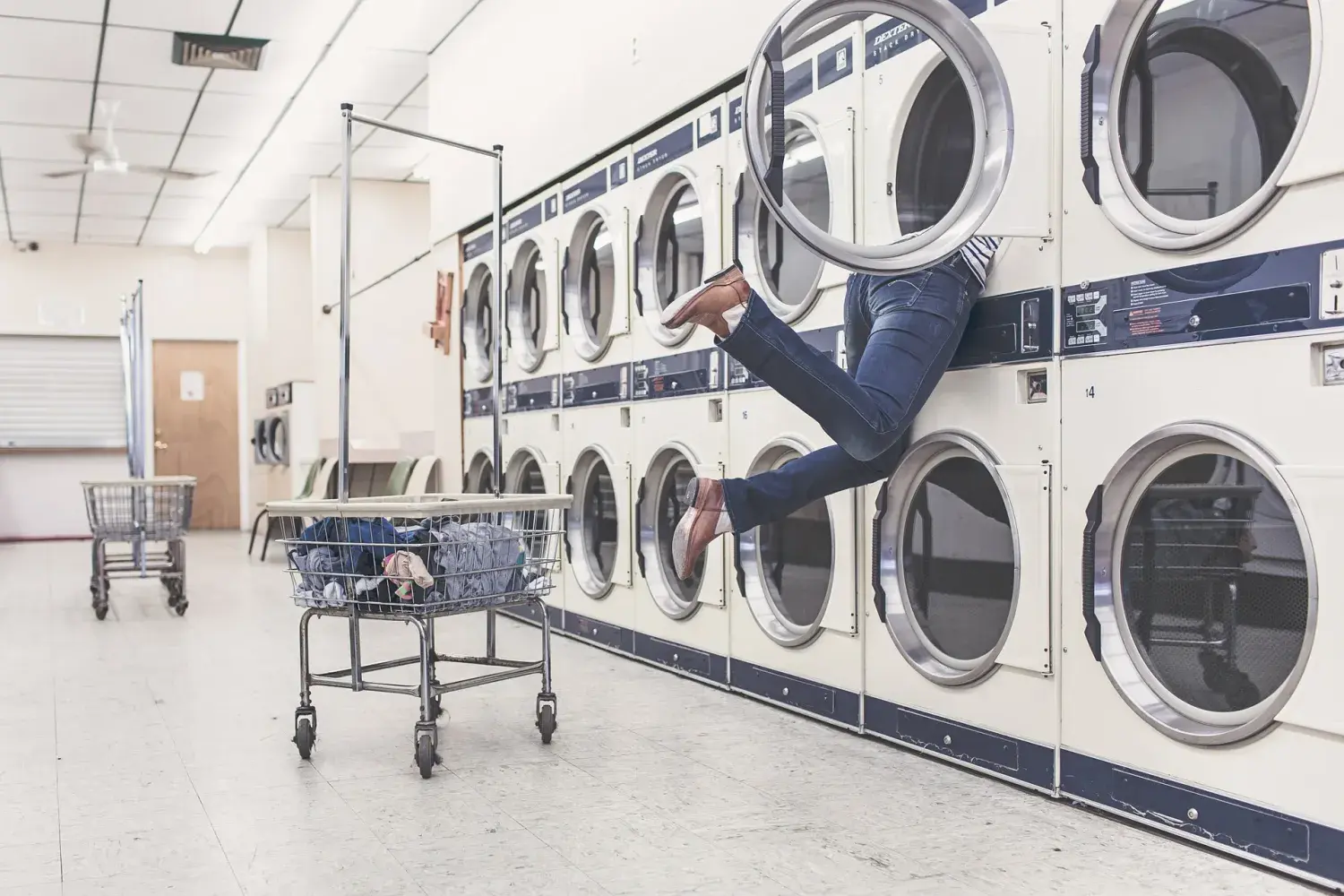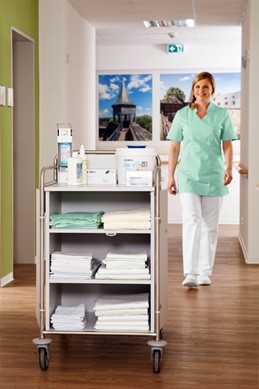Strict hygiene requirements apply in an array of professions and fields, for example in healthcare and gastronomy – and washing is no exception. Four studies have shown the extent to which these can be satisfied with domestic washing machines and whether industrial laundries comply with the requirements. We have summarised the results for you.
“Not just clean, but hygienically clean” – was the slogan used by a well-known detergent manufacturer to advertise its product successfully for many years. And it’s true: the difference between clean and hygienically clean is more important than you might think in some areas. In healthcare, residential and care homes and the gastronomy sector, ‘clean’ textiles are not always enough. Special hygiene requirements apply in these fields that domestic washing machines cannot always satisfy.
The care of workwear and protective clothing is also an important issue for tradespeople: the workwear must protect its wearer and, at the same time, communicate a professional image to the customer. Inadequate washing can damage the clothes’ protective function or leave long-lasting marks on the fabric.
Four scientific studies have now taken a closer look at the role of hygiene in washing, revealing how important professional textile services are in these segments for the health of patients, staff and guests.
Inefficiency of domestic washing
In the scope of the study “Hygienische Aufbereitung von Textilien in Privathaushalten - eine Studie aus der Praxis” (Hygienic Reprocessing of Textiles in Private Households – A Practical Study)1, the Hochschule Niederrhein University of Applied Sciences investigated how well dirty clothes are cleaned at home. The result: washing of textiles in domestic washing machines is not sufficient to satisfy the hygiene requirements in the healthcare and gastronomy sectors. Bacteria and germs are not rendered inactive to a sufficient extent.

A number of parameters such as the temperature and detergent as well as the time for which the laundry remains in the water with the detergent are important for achieving the desired and requisite level of hygiene. These are parameters that domestic washing machines do not deliver.
Personal habits and the different performance of machines also contribute to bacteria remaining active after the washing procedure. Another aspect is the lack of possibility to check the microbiologically hygienic quality of textiles at home. The authors conclude: For this reason, textiles worn in very sterile environments such as the healthcare sector, foodstuffs industry or residential and care homes should be washed by professional textile service providers.
Laundry in residential and care homes
There is often no standardised protocol for the clothing of residents and patients in care homes, which can have serious consequences for their health. Studies confirm that germs on the clothes originating from faecal matter or urine, for example, can be spread among the residents. For this reason, the clothing of infectious residents should be washed in accordance with the same hygiene standards as the bed linen.

This is the conclusion of the “Verarbeitung von privater Kleidung und Bettwäsche in Alten- und Pflegeheimen” (Processing of Private Laundry and Bed Linen in Residential and Care Homes) study2, published by Charlottenburg-Wilmersdorf Local Health Authority in Berlin. The local health authority therefore recommends that the laundry be washed in industrial washing machines or its washing entrusted to a professional textile service provider.
Hygiene control management in industrial laundries
Industrial laundries employ hygiene management systems in order to satisfy the hygiene requirements in healthcare and gastronomy. Manuel Heintz and Jürgen Bohnen, the authors of the “Hygiene in gewerblichen Wäschereien” (Hygiene in Industrial Laundries) study3, investigated compliance with the Robert Koch Institute’s (RKI) hygiene requirements and Risk Analysis and Biocontamination Control (RABC) quality management system in the scope of a hygiene test conducted at ten industrial laundries.
The tests included washing processes with textiles contaminated with bacteria as well as dry and damp textiles. The transfer of the bacteria to hands and surfaces as well as the water quality and air quality were also analysed. The results were equally satisfactory across the board: all of the dry textile samples were free of bacteria and the test values were complied with for the wet laundry.
As such, the findings of the study were that industrial laundries in both the healthcare and foodstuffs sectors employ efficient processes which ensure compliance with the hygiene requirements.
Hygiene risks of domestic laundry
Precisely this is not the case for textiles washed at home and there is a specific reason for this: washing in a domestic context is primarily concerned with removing stains and freshening up the laundry. In general, little to no attention is paid to the fact that the clothing may also be contaminated with germs. Bacteria are often not effectively rendered inactive when laundry is washed at temperatures below 60°C in particular. The use of detergents without bleach also increases the risk of bacteria remaining active.
Pathogenic spores in particular remain active and thus also pose a potential risk of infection after washing. This was the conclusion reached by Dirk Bockmühl from Rhine-Waal University of Applied Sciences, who conducted the “Hygieneaspekte in der Haushaltswäsche” (Hygiene Aspects in Domestic Laundry) study4.
Four studies – one finding
The four studies confirm that it is not possible to comply with the requirements in the healthcare and gastronomy sectors with a standard domestic washing machine. The risk of bacteria and germs remaining active – without being noticed at home – is too high.
For this reason, companies – especially healthcare facilities and gastronomy enterprises – who want to ensure compliance with hygiene requirements should entrust this responsibility to a professional textile service provider. This also applies for the personal clothing of residents and patients in care homes when there are no clear protocols in place. Exercising caution here can minimise the risk for all involved.
Any questions? Get in contact with us!
Sources
[1] Sascha Bellante, Anna Engel, Tecir Hatice, Anissa Neumann, Gamze Okyay, Miriam Peters, Lutz Vossebein: “Hygienische Aufbereitung von Textilien in Privathaushalten - eine Studie aus der Praxis” (Hygienic Reprocessing of Textiles in Private Households – A Practical Study), Hochschule Niederrhein University of Applied Sciences, Research Centre FB07: Research Institute for Textile and Clothing (FTB), Mönchengladbach, Germany
[2] Nicoletta Wischnewski: “Verarbeitung von privater Kleidung und Bettwäsche in Alten- und Pflegeheimen” (Processing of Private Laundry and Bed Linen in Residential and Care Homes), Charlottenburg-Wilmersdorf Health Centre, Berlin, Germany
[3] Manuel Heintz, Jürgen Bohnen: “Hygiene in gewerblichen Wäschereien” (Hygiene in Industrial Laundries), wfk - Cleaning Technology Institute e.V., Krefeld, Germany
[4] Dirk Bockmühl: “Hygieneaspekte in der Haushaltswäsche” (Hygiene Aspects in Domestic Laundry), Hygiene and Microbiology, Rhine-Waal University of Applied Sciences, Germany

